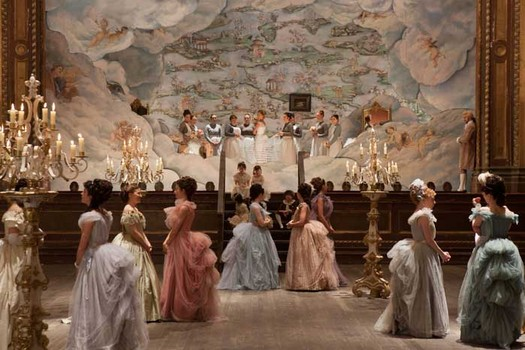If you’ve ever watched breathlessly as Mr. Darcy and Lizzie Bennett exchange acid barbs in the middle of a dance, or been obsessed with Keira Knightley’s green dress in Atonement (you know the one), you have Joe Wright to thank.
Wright, who directed Pride and Prejudice (2005), Anna Karenina (2012), the newly-released Cyrano (2022) and more, is one of my favorite directors. His attention to detail, eye for aesthetic beauty and penchant for perfectly-executed tracking shots are the hallmarks of his directorial style. They are also traits that allow him to breathe life into centuries-old stories that might become stale period pieces in the hands of a less-skilled director.
 |
| Atonement (2007) |
In a recent interview with the American Cinematographer, he gave some insight into his creative process and his collaboration with award-winning cinematographer Seamus McGarvey:
“I delineate two weeks of table-time for Seamus and me in preproduction. That period is sacrosanct to me and usually comes after rehearsals, when we have a sense of the rhythms of the scenes. Rhythm is as important to me as picture. It can be the rhythm of the actors, their dialogue, camera movement and/or editing. It can also mean compositional rhythm in terms of light, shade and color within the frame. To me, rhythm is the primary tool of a filmmaker, which is why I think film is most akin to music.”
Here he employs analogy to frame his thoughts and draw a connection between sight and sound, word and movement. Wright and McGarvey’s creative sessions are also an example of divergent thinking, where they bounce ideas off each other until they find the right groove for the film.
 |
| Anna Karenina (2012) |
McGarvey added that “music is very important to Joe. He has a metronomic beat in his mind of the entire movie, and every department — including grip, camera, costumes, production design and cast — all dance to that same beat.”
It’s not just the director and cinematographer who feel this way, critics have picked up on the musicality of Wright’s films. Bilge Ebiri of The Village Voice writes, “with Darkest Hour, Wright has returned to the kind of filmmaking that put him on the map: taking serious, potentially somber material and reinventing it for the screen through intricate, inventive cinematic technique. (At times, it feels like we’re watching a musical, even though nobody sings in the film.)”
Wright is meticulous and deliberate in his directing, often composing shots inspired by classical paintings — and sometimes featuring them.
 |
| Pride and Prejudice (2005) |
“I never want to cut without a reason,” he explained in the American Cinematographer interview. “A cut is one of the most potent tools we have, rhythmically and cinematically. I’m interested in investigating the potential of a shot and playing it to its last point.”
It is this level of care and precision that has garnered Wright numerous accolades and the adoration of film lovers across the world (myself included). If you have some free time this weekend I encourage you to pop some popcorn and settle down to watch a Joe Wright film — you won’t regret it.
Sources:
https://ascmag.com/articles/collaborative-process-cyrano
https://www.villagevoice.com/2017/11/20/style-is-a-difficult-word-for-me-joe-wright-on-his-winston-churchill-drama-darkest-hour/
https://www.imdb.com/name/nm0942504/?ref_=nmawd_awd_nm
https://www.imdb.com/name/nm0568974/?ref_=nv_sr_srsg_0
Atonement has been one of my all time favorite movies for a while now, I had no idea Joe Wright was the director! I absolutely love everything about the film. Like you were talking about, Wright found a way to make a period piece love story into so much more. I've never been able to put my finger on why I love Atonement so much but now it makes more sense to me. Wright finds a way to incorporate everything from music to costume design in every shot. I'm thinking I might have to go back and rewatch Atonement, AGAIN!
ReplyDeleteThis was such an interesting post! I love his films and now understand his technique so much better. The comparison of rhythm to not only sound but image and plot makes his movies have a flow that is unparalleled. The last quote you gave about how he views the act of "cut" is so interesting. To him, the cut could prevent future cinematic potential so he would rather see the scene through and what could come of it. These are incredibly influential films, and Wright's creative directing has propelled them into fame.
ReplyDeleteI am obsessed with Pride and Prejudice (2005) and have always appreciated its cinematography but had no idea who was behind it! What particularly struck me about Wright's creative process is his commitment to playing everything out. I think it can be an impulse reaction to just abandon ship when we see things are going downhill, but I think we can often lose a lot of valuable insight in doing so. His meticulous dedication to fleshing out all the possibilities a shot or scene has to offer must be a huge reason for his success, in my opinion! Thanks for sharing!
ReplyDelete